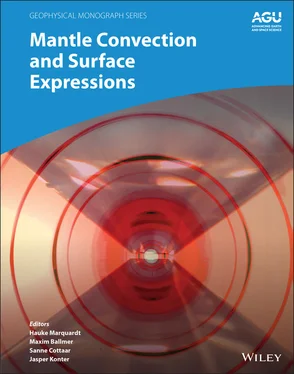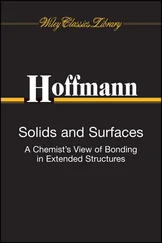The Rotational Drickamer Apparatus (RDA) is an opposed anvil device, where one anvil has the capability to rotate. Pressure and compressive stress are increased by advancing the anvils. When the desired pressure is reached, large shear strain can be induced by rotation of the anvil (Yamazaki & Karato, 2001a). The RDA can reach P‐T conditions of the upper lower mantle ~27 GPa at ~2100 K (Girard et al., 2016). The main advantages of the RDA are that it can reach higher pressures than other large‐volume techniques and can reach high shear strains. However, the RDA is limited to smaller samples than the above multianvil techniques and also has larger temperature and pressure gradients. Due to the fact that deformation is induced by rotation of the anvils, the RDA also has large strain gradients across the sample, though this is somewhat alleviated by using a doughnut‐shaped sample. Generally speaking, the large volume apparatuses are far superior to the DAC in terms of measuring rheological properties but lack the pressure range available in the DAC, and thus, currently these two types of techniques are complementary for understanding deformation of lower mantle phases.
2.3.3 Texture and Strength Measurements in High‐Pressure Experiments
For samples deformed in axial compression, lattice planes perpendicular to compression are more reduced in spacing relative to planes perpendicular to the radial direction (Singh, 1993; Singh et al., 1998). This is due to elastic strain imposed by the deformation device. If single crystal elastic properties are known, differential stress supported by the sample can be calculated from measured lattice strains (Singh, 1993; Singh et al., 1998). Stresses measured during these experiments can provide a lower bounds estimate for the flow strength of the material (Kavner & Duffy, 2001; Merkel et al., 2002). During plastic deformation, lattice strains may become systematically larger or smaller on various crystallographic planes, as stress is anisotropically relieved by dislocation motion. Frequently, in high‐pressure experiments, aggregate flow strength is taken to be an arithmetic mean of stresses calculated on the measured lattice plane. This method can be biased, depending on which lattices planes are measured. Lattice strain anisotropy does provide information on active deformation mechanisms and can be used to constrain slip system activities (Karato, 2009; Turner & Tomé, 1994). Texture development is an expression of plastic deformation and results from dislocation glide/creep and/or mechanical twinning. Texture is easily observed with radial x‐ray diffraction as systematic intensity variations along diffraction rings. By deconvoluting these intensity variations, textures can be measured in‐situ in DACs or large volume deformation devices (Wenk, Lonardelli, et al., 2006). For an example methodology of texture analysis from radial x‐ray diffraction the reader is referred to Wenk et al. (2014).
Deformation mechanisms can be inferred from high‐pressure experiments by forward modeling texture development and/or lattice strain evolution with polycrystal plasticity codes. Although full field methods such as finite elements (Castelnau et al., 2008) or Fast Fourier Transform methods (Kaercher et al., 2016) can be used to model deformation behavior, homogenization schemes such as the self‐consistent method are more common (Merkel et al., 2009; Wenk, Lonardelli, et al., 2006). This is due to the high degree of efficacy coupled with considerably reduced computational expense for self‐consistent methods. The most commonly used method is the Visco Plastic Self‐Consistent (VPSC) code (Lebensohn & Tomé, 1993), which simulates texture development as a function of slip system activities. The VPSC method has been further modified to account for the effects of recrystallization (e.g., Wenk et al., 1997). Although VPSC can account for large strains and rate sensitive deformation, it neglects elastic deformation. As such, it does not account for hydrostatic pressure and cannot be used to model lattice strains. On the other hand, the Elasto‐Plastic Self Consistent (EPSC) method (Turner & Tomé, 1994) can be used to model slip system activities as a function of lattice strain evolution. However, strictly speaking, the strain formulation used in EPSC is applicable to small strains and does not include rate‐sensitive deformation. Early implementations of EPSC did not account for texture development due to slip and twinning or grain shape evolution. The EPSC method has been extended to include grain reorientation and stress relaxation due to twinning (Clausen et al., 2008) and then further modified to approximately account for large strains, ridged body rotation, texture, and grain shape evolution (Neil et al., 2010). This version of EPSC has been used to model texture and lattice strain evolution in high‐pressure experiments (e.g., Li & Weidner, 2015; Merkel et al., 2012; Raterron et al., 2013). Most recently, a fully general, rate sensitive, large‐strain Elasto‐Visco Plastic Self‐Consistent (EVPSC) method was developed (H. Wang et al., 2010) and applied to high‐pressure deformation (F. Lin et al., 2017) to simultaneously model lattice strain and texture evolution. One advantage of EVPSC is that it can effectively simulate large strain texture and lattice strain development to provide quantitative values for polycrystal critical resolved shear stresses (CRSS) and to constrain secondary slip systems (F. Lin et al., 2017).
In self‐consistent codes, each grain is treated as an inclusion in an anisotropic, homogeneous medium that has the average properties of the polycrystal. In VPSC and EVPSC, rate sensitivity of slip systems is included as a power law behavior. As deformation proceeds, crystals deform and rotate to generate texture. The resulting texture depends on the active slip systems and deformation geometry. Slip system activity depends on the stress resolved onto the slip systems and the critical resolved shear stress (CRSS) needed to activate the slip system. Applying different CRSS values favors one slip system over others. Different dominant slip systems result in different texture types and different lattice strain anisotropies. By determining which simulated texture and lattice strain evolution most closely resembles experiments, deformation mechanism can be inferred.
2.3.4 A Note on Scaling Experiments to the Lower Mantle
Caution should be exercised when extrapolating laboratory results to the deep Earth. First and foremost, laboratory strain rates are many orders of magnitude faster than natural strain rates. Laboratory strain rates for deformation of lower mantle phases are typically on the order of 10 −4s −1to 10 −7s −1. In contrast, strain rates in the Earth are likely on the order of 10 −12s −1to 10 −16s −1. Given the large difference in the human time scale and geologic time this discrepancy cannot be addressed directly by laboratory studies and systematic trends from laboratory experiments must be extrapolated to conditions of the Earth. One potential pitfall with this is the underlying assumption that no unknown deformation mechanism exists that operates at mantle conditions but is not operative in the laboratory (Boioli et al., 2017). Unlike the crust and upper mantle, natural samples that can provide evidence of operative deformation mechanisms do not exist and thus one is left to use the best data from the laboratory and from theory.
Total strain achieved in experiments can also be quite different than those in nature. While some devices can achieve large strains, for example the RDA has been used to achieve shear strains of ~2 (200%) (Y. Xu et al., 2005) and the rotational DAC has been used to deform samples to shear strains of ~4 (400%) (Nomura et al., 2017), compression studies typically attain strains of ~0.3 strain (30%) (e.g., Marquardt & Miyagi, 2015; Y. Wang et al., 2003). In contrast, slabs subducted into the lowermost mantle likely experience much larger shear strains on the order of 6–10 (e.g., Allègre & Turcotte, 1986; Tommasi et al., 2018; Wenk et al., 2011).
Читать дальше












